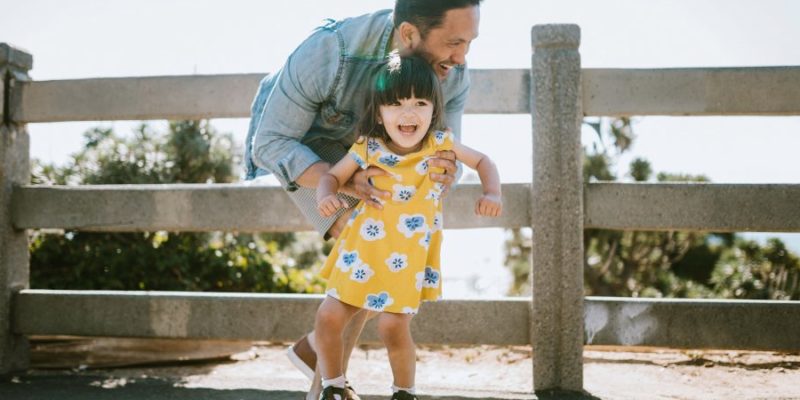If there are two things business leaders want to talk about besides businesses, two topics seem to live near the top of the list:
This is why I jumped at the chance to talk with Rachael Katz and Helen Shwe Hadani, authors of the new book, The Emotionally Intelligent Child: Effective Strategies for Parenting Self-Aware, Cooperative, and Well-Balanced Kids.
Research shows that children who develop high emotional intelligence become more successful in life, Hadani explained: “a higher chance of graduating, getting a good job, and just being happy.”
So, I asked Katz and Hadani if we could break down their top habits for parents who want to raise emotionally successful kids. Here’s what they came up with.
1. Look out for the disconnects.
This first bit of advice might seem obvious, but it’s harder in practice.
In short, children develop their understanding of emotions, thoughts, beliefs, intents and desires over time. Then there’s a whole additional level to really internalize the idea that other people have their own mental states.
Remembering this is good advice for any interaction, but it’s especially important in adult-child relationships.
“You think, ‘My child doesn’t understand! I keep saying this, but they keep doing the same thing!'” Katz said. “e get so frustrated, but but the thing to remember is that it might just be developmental.”
2. Think about how to communicate through play.
Younger children especially learn through play. So, meet them where they are: gamify life, make things fun when you can, and play with them.
“We say to develop executive function skills through really classic and playful games like Simon Says, and Red Light/Green Light,” Hadani said, “that develop the executive function skills of self control and inhibition. It seems like common sense, but play is the way children learn.”
“We use a lot of puppets,” Katz added. “They’re a break, they’re novel. Kids respond when things are novel.”
3. Model your thinking out loud.
One of my favorite things about emotional intelligence is how much it relies on precision of language, so that you communicate the things you want to communicate, but don’t unintentionally communicate other things.
With kids, this can mean literally explaining what you’re doing out loud — modeling your thinking — both so that they’ll understand better in the short-term, and so they’ll have the language tools they need in the longer term.
“It’s how you get children to think about their thinking,” Katz said. “You can think out loud. Model what it looks like to think out loud.”
4. Plant the seeds of self-compassion.
Once you’ve started modeling your thinking out loud; as kids get a bit older, Katz and Hadani recommend modeling your feelings out loud, too. As Katz put it:
“This is where you’re talking out loud, and you say — or you can say to your kids — you know, sometimes I tell myself, ‘I’m not OK.’ And then, you can ask, ‘Do you get that too? Does your inner voice ever tell you a message like that you’re not OK?’
When kids learn that, they’re so excited. They’re just chomping at the bit to tell you what their inner voice is saying.”
The point here is both to let them recognize that everyone has these inner voices critiquing their situations, and also to “plant the seeds of self-compassion,” as both co-authors explained, so that they grow up realizing it’s OK to deal with these contradictions.
5. Realize the disconnect between body language and speech.
Language development in children starts even before they begin talking, as they communicate by watching body language, and listening for tone of voice. When they grow a bit older, however, the disconnection that we sometimes display between verbal and nonverbal communication can be especially confusing.
“That’s a big part of social emotional learning,” Hadani said, “learning to read that somebody is more than the words that they’re saying. So, we talk a lot about what’s called ‘pragmatics,’ in the book, which are the unwritten rules of language. Children start to understand those even in the in the preschool years.”
6. Talk out loud about emotion.
Much like modeling your thinking out loud, Katz and Hadani recommend speaking plainly and matter-of-factly about emotion, for the simple reason that children gain their language skills for recognizing emotions from their interactions with adults.
In other words, we can change that which we can measure, but we can only measure that which we can articulate. So talking out loud about gives kids tools to understand their own feelings.
“There’s research showing with preschool aged children, parents who read books with them that talk more about the emotions of the characters, those children tend to develop more pro social behaviors,” Hadani said. “We want them to be helpful and compassionate, and have empathy. And research shows that the way to do that is to talk about emotions.”
7. Ask instead of tell.
With both children and adults, it’s often more effective to get people committed to a course of action, and to learn from its results, if they feel that they’ve been invited to participate in planning it.
So, Hadani and Katz recommend that when possible, to ask kids for ideas on how to accomplish things, rather than simply telling them, and afterward, review how they worked out.
“A transition plan might look like, “Hey, we’re about to leave the house and go to school,” Katz said. “Are you ready for this? What’s it going to look like? What are you going to do first?’ If you allow the child to articulate the plan, they can internalize it. But, if I simply tell them, they don’t go through that process, because it’s not derived from them.”
8. Embrace emotional change.
You know what? I think we use the word ‘happy” to mean too many different things: contentment, joy, excitement, and other emotions.
This goes a step further with children, because besides differentiating emotions, they have have to learn that emotions aren’t constant. People who seem like they’re usually happy can sometimes be sad, for example, it’s possible to feel several different emotions at the same time.
“We talk about happiness, as if it should be a fixed state,” Katz said. “But in fact, your moods are constantly changing. So just ask: What is your mood at this moment? And then kids are like, wait a minute. I’m feeling sad. Or, I was feeling happy.”
9. Try not to judge.
Here’s the final habit, and it’s so far reaching that it might well be my favorite.
If you’re trying to “build the architecture of emotional intelligence,” as Katz and Hadani put it, remember that nobody gets this perfect: not children, and not the parents.
“Stay away from shame, blame and criticism. It’s hard, but I mean, this isn’t a perfect world. There is no perfect,” said Katz. “You don’t always have on top of this for your kids. But when there’s timeliness, and when we slow down and pay attention to what our child is doing, those are good opportunities.”
Kids and emotional intelligence
There is always a lot more to talk about with both of these subjects, which is probably why my two free ebooks, How to Raise Successful Kids (7th Edition), and 9 Smart Habits of People With Very High Emotional Intelligence have had so many downloads.
“We joke about it,” Katz said. “This is our civic duty, to help parents understand emotional intelligence. It’s our mission. It’s our duty to share.”











Comments